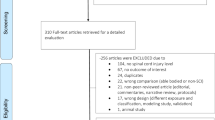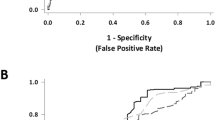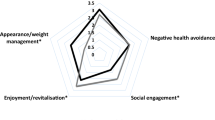Abstract
Study Design
This is a cross-sectional study.
Objectives
To describe the association between cardiovascular risk factors (body mass index (BMI), waist circumference (WC), blood pressure, blood glucose and lipids) and leisure time physical activity (LTPA) in older adults with long-term spinal cord injury (SCI).
Setting
Community settings, southern Sweden.
Methods
Data from the baseline data collection of the Swedish Aging with Spinal Cord Injury Study (SASCIS) (n = 123, 71% men, injury levels C1-L5, American Spinal Injury Association Impairment Scale A-D, mean age 63 years, mean time since injury 24 years). Data were collected through home interviews, assessments and blood samples. The Physical Activity Recall Assessment for People with SCI was used to assess LTPA. Associations were investigated using multivariable linear regression analyses adjusted for age, gender, level and severity of injury, cause of injury, time since injury and tobacco use.
Results
More minutes per day of moderate-to-heavy LTPA were significantly associated with a lower BMI (Beta = −0.31; p = 0.001) and a lower WC (Beta = −0.24; p = 0.009). More minutes per day of total LTPA (mild intensity or greater) were associated with a higher systolic blood pressure (Beta = 0.27; p = 0.041) among participants with tetraplegia. No other significant associations between the cardiovascular risk factors and total LTPA were found.
Conclusion
Participation in daily LTPA is associated with better cardiovascular health with regard to BMI and WC in older adults with long-term SCI. Further studies are needed to establish the specific amount of activity needed to obtain positive health effects in this group and the directional causality of the associations.
Sponsorship
Not applicable.
Similar content being viewed by others
Log in or create a free account to read this content
Gain free access to this article, as well as selected content from this journal and more on nature.com
or
References
Warburton DER, Krassioukov A, Sproule S, Eng JJ. Cardiovascular health and exercise following spinal cord injury. In: Eng JJ, Teasell RW, Miller WC, Wolfe DL, Townson AF, Hsieh JTC, et al., editors. Spinal cord injury rehabilitation evidence, version 5. 2014. p. 1–48. https://scireproject.com/evidence/rehabilitation-evidence/cardiovascular-health-and-exercise/. Accessed August 15, 2018.
Wahman K, Nash MS, Lewis JE, Seiger Å, Levi R. Increased cardiovascular disease risk in Swedish persons with paraplegia: The Stockholm spinal cord injury study. J Rehabil Med. 2010;42:489–92.
Myers J, Lee M, Kiratli J. Cardiovascular disease in spinal cord injury: an overview of prevalence, risk, evaluation, and management. Am J Phys Med Rehabil. 2007;86:142–52.
Savic G, Charlifue S. Aging with spinal cord injury. In: Chhabra HS, editor. ISCoS textbook on comprehensive management of spinal cord injuries.1st ed, Haryana, India: Lippincott Williams & Wilkins; 2015. p. 906–17.
Garshick E, Kelley A, Cohen S, Garrison A, Tun CG, Gagnon D, et al. A prospective assessment of mortality in chronic spinal cord injury. Spinal Cord. 2005;43:408–16.
Savic G, DeVivo MJ, Frankel HL, Jamous MA, Soni BM, Charlifue S. Causes of death after traumatic spinal cord injury-a 70-year British study. Spinal Cord. 2017;55:891–7.
Jensen MP, Truitt AR, Schomer KG, Yorkston KM, Baylor C, Molton IR. Frequency and age effects of secondary health conditions in individuals with spinal cord injury: a scoping review. Spinal Cord. 2013;51:882–92.
Groah SL, Weitzenkamp D, Sett P, Soni B, Savic G. The relationship between neurological level of injury and symptomatic cardiovascular disease risk in the aging spinal injured. Spinal Cord. 2001;39:310–7.
World Health Organization. Global recommendations on physical activity for health. Geneva, Switzerland: World Health Organization; 2010.
Catapano AL, Graham I, De Backer G, Wiklund O, Chapman MJ, Drexel H, et al. 2016 ESC/EAS Guidelines for the Management of Dyslipidaemias. Eur Heart J. 2016;37:2999–3058.
Martin Ginis KA, Latimer AE, Buchholz AC, Bray SR, Craven BC, Hayes KC, et al. Establishing evidence-based physical activity guidelines: methods for the Study of Health and Activity in People with Spinal Cord Injury (SHAPE SCI). Spinal Cord. 2008;46:216–21.
Buchholz AC, Martin Ginis KA, Bray SR, Craven BC, Hicks AL, Hayes KC, et al. Greater daily leisure time physical activity is associated with lower chronic disease risk in adults with spinal cord injury. Appl Physiol Nutr Metab. 2009;34:640–7.
van der Scheer JW, Martin Ginis KA, Ditor DS, Goosey-Tolfrey VL, Hicks AL, West CR, et al. Effects of exercise on fitness and health of adults with spinal cord injury: a systematic review. Neurology. 2017;89:736–45.
Martin Ginis KA, van der Scheer JW, Latimer-Cheung AE, Barrow A, Bourne C, Carruthers P, et al. Evidence-based scientific exercise guidelines for adults with spinal cord injury: an update and a new guideline. Spinal Cord. 2018;56:308–21.
Groah SL, Charlifue S, Tate D, Jensen MP, Molton IR, Forchheimer M, et al. Spinal cord injury and aging: challenges and recommendations for future research. Am J Phys Med Rehabil. 2012;91:80–93.
Jörgensen S. Older adults with long-term spinal cord injury [dissertation]. Lund: Lund University; 2017.
Jörgensen S, Martin Ginis KA, Lexell J. Leisure time physical activity among older adults with long-term spinal cord injury. Spinal Cord. 2017;55:848–56.
Martin Ginis KA, Latimer AE, Arbour-Nicitopoulos KP, Buchholz AC, Bray SR, Craven BC, et al. Leisure time physical activity in a population-based sample of people with spinal cord injury part I: demographic and injury-related correlates. Arch Phys Med Rehabil. 2010;91:722–8.
Jörgensen S, Hill M, Lexell J. Cardiovascular risk factors among older adults with long-term spinal cord injury. PM R. 2018. https://doi.org/10.1016/j.pmrj.2018.06.008.
Flank P, Fahlström M, Boström C, Lewis JE, Levi R, Wahman K. Self-reported physical activity and risk markers for cardiovascular disease after spinal cord injury. J Rehabil Med. 2014;46:886–90.
Jörgensen S, Iwarsson S, Norin L, Lexell J. The Swedish Aging with Spinal Cord Injury Study (SASCIS): methodology and initial results. PM R. 2016;8:667–77.
Jörgensen S, Iwarsson S, Lexell J. Secondary health conditions, activity limitations, and life satisfaction in older adults with long-term spinal cord injury. PM R. 2017;9:356–66.
Jörgensen S, Martin Ginis KA, Iwarsson S, Lexell J. Depressive symptoms among older adults with long-term spinal cord injury: Associations with secondary health conditions, sense of coherence, coping strategies and physical activity. J Rehabil Med. 2017;49:644–51.
Kirshblum SC, Burns SP, Biering-Sorensen F, Donovan W, Graves DE, Jha A, et al. International standards for neurological classification of spinal cord injury (revised 2011). J Spinal Cord Med. 2011;34:535–46.
Martin Ginis KA, Latimer AE, Hicks AL, Craven BC. Development and evaluation of an activity measure for people with spinal cord injury. Med Sci Sports Exerc. 2005;37:1099–111.
Martin Ginis KA, Latimer AE. Physical activity recall assessment for people with spinal cord injury: administration and scoring manual. Hamilton, Ontario, Canada: McMaster University; 2008.
Pelletier CA, Omidvar M, Miyatani M, Giangregorio L, Craven BC. Participation in moderate-to-vigorous leisure time physical activity is related to decreased visceral adipose tissue in adults with spinal cord injury. Appl Physiol Nutr Metab. 2018;43:139–44.
Psaltopoulou T, Hatzis G, Papageorgiou N, Androulakis E, Briasoulis A, Tousoulis D. Socioeconomic status and risk factors for cardiovascular disease: Impact of dietary mediators. Hell J Cardiol. 2017;58:32–42.
Krause JS, Cao Y, DeVivo MJ, DiPiro ND. Risk and protective factors for cause-specific mortality after spinal cord injury. Arch Phys Med Rehabil. 2016;97:1669–78.
Krause JS, Carter RE, Pickelsimer EE, Wilson D. A prospective study of health and risk of mortality after spinal cord injury. Arch Phys Med Rehabil. 2008;89:1482–91.
Eriksson M, Lindström B. Antonovsky’s sense of coherence scale and the relation with health: a systematic review. J Epidemiol Community Health. 2006;60:376–81.
Carvalho DC, Cliquet A, Jr. Response of the arterial blood pressure of quadriplegic patients to treadmill gait training. Braz J Med Biol Res. 2005;38:1367–73.
Faghri PD, Glaser RM, Figoni SF. Functional electrical stimulation leg cycle ergometer exercise: training effects on cardiorespiratory responses of spinal cord injured subjects at rest and during submaximal exercise. Arch Phys Med Rehabil. 1992;73:1085–93.
Bresnahan JJ, Farkas GJ, Clasey JL, Yates JW, Gater DR. Arm crank ergometry improves cardiovascular disease risk factors and community mobility independent of body composition in high motor complete spinal cord injury. J Spinal Cord Med. 2018. https://doi.org/10.1080/10790268.2017.1412562.
Latimer AE, Martin Ginis KA, Craven BC, Hicks AL. The physical activity recall assessment for people with spinal cord injury: validity. Med Sci Sports Exerc. 2006;38:208–16.
Nightingale TE, Rouse PC, Thompson D, Bilzon JLJ. Measurement of physical activity and energy expenditure in wheelchair users: Methods, considerations and future directions. Sports Med Open. 2017;3:10.
Acknowledgements
We are grateful to all participants. We also wish to thank Lizette Norin, BSc, Department of Health Sciences, Lund University, for assistance during the data collection.
Funding:
This study was carried out within the framework of the Swedish Aging with Spinal Cord Injury Study (SASCIS), financed by research grants from the Swedish Research Council, the Norrbacka-Eugenia Foundation, the Promobilia Foundation, the Research Fund of Neuro Sweden, the Swedish Association for Survivors of Accident and Injury (RTP), Gun and Bertil Stohne’s Foundation, the Ribbingska Foundation in Lund, and the Gustaf V and Queen Victoria’s Freemason Foundation. The baseline data collection in the SASCIS was accomplished within the context of the Centre for Ageing and Supportive Environments (CASE), Lund University, financed by the Swedish Research Council for Health, Working Life and Welfare.
Author contributions:
The SASCIS was initiated and designed by SJ and JL. SJ, KMG and JL designed the present study, SJ performed the data analyses and drafted the manuscript in collaboration with SS, LM and JL. All authors critically revised the manuscript and all authors have read and approved the final version of the manuscript.
Author information
Authors and Affiliations
Corresponding author
Ethics declarations
Conflict of interest
The authors declare that they have no conflict of interest.
Ethical approval
The principles of the Declaration of Helsinki for research on humans were followed and the SASCIS was approved by the Regional Ethical Review Board in Lund, Sweden (number 2010/692). All participants were given written and oral information about the study before providing their written informed consent to participate. We certify that all applicable institutional and governmental regulations concerning the ethical use of human volunteers were followed during the course of this research.
Additional information
Publisher’s note: Springer Nature remains neutral with regard to jurisdictional claims in published maps and institutional affiliations.
Rights and permissions
About this article
Cite this article
Jörgensen, S., Svedevall, S., Magnusson, L. et al. Associations between leisure time physical activity and cardiovascular risk factors among older adults with long-term spinal cord injury. Spinal Cord 57, 427–433 (2019). https://doi.org/10.1038/s41393-018-0233-5
Received:
Revised:
Accepted:
Published:
Issue date:
DOI: https://doi.org/10.1038/s41393-018-0233-5
This article is cited by
-
Obesity in wheelchair users with long-standing spinal cord injury: prevalence and associations with time since injury and physical activity
Spinal Cord (2024)
-
Sense of coherence and changes over six years among older adults aging with long-term spinal cord injury
Spinal Cord (2021)
-
Role of exercise on visceral adiposity after spinal cord injury: a cardiometabolic risk factor
European Journal of Applied Physiology (2021)
-
Defining accelerometer cut-points for different intensity levels in motor-complete spinal cord injury
Spinal Cord (2020)



